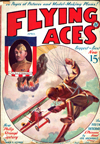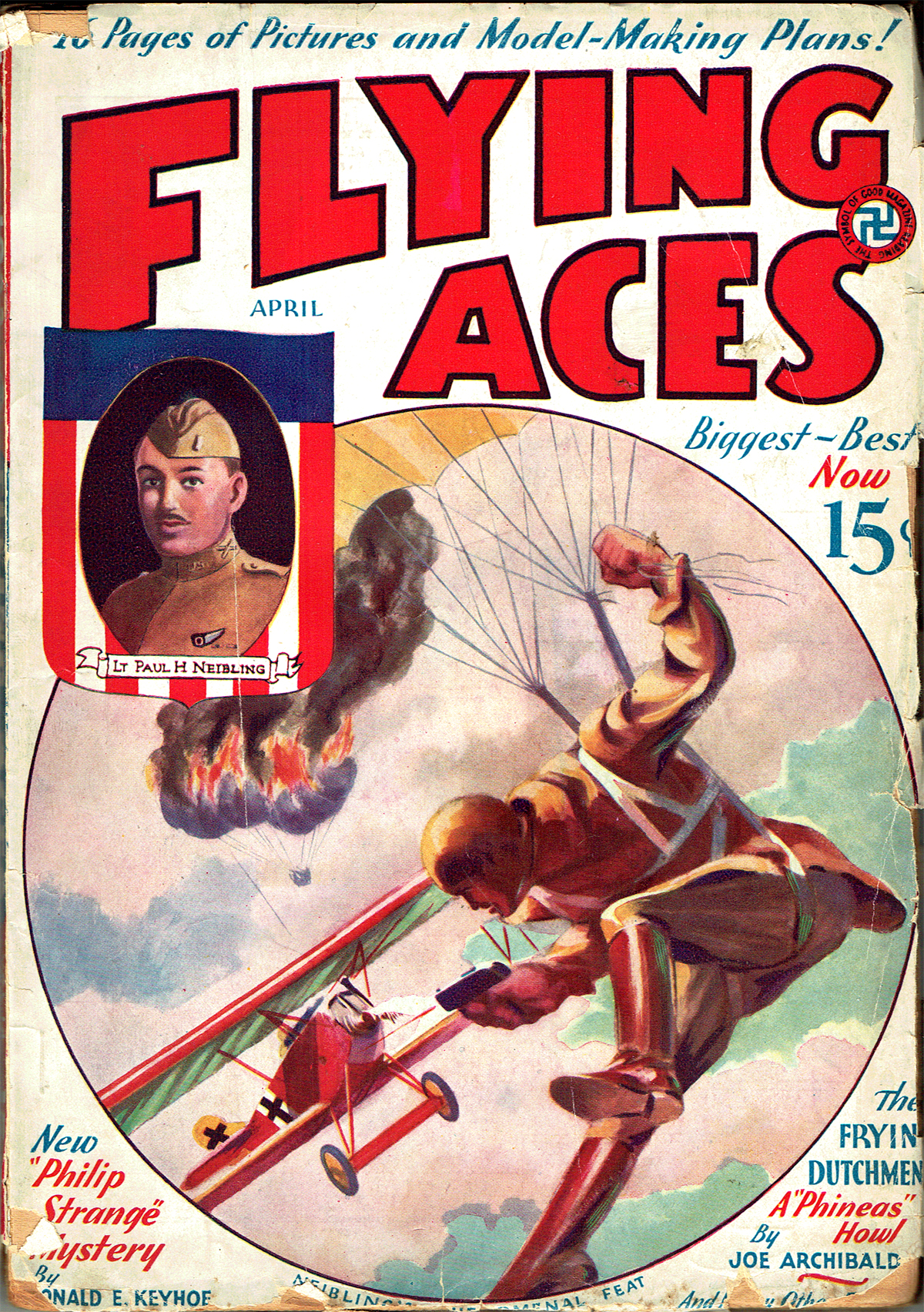“Niebling’s Phenomenal Feat” by Paul Bissell
THIS week we present “Niebling’s Phenomenal Feat”—The story behind Paul Bissell’s April 1933 cover for Flying Aces! Bissell is mainly known for doing the covers of Flying Aces from 1931 through 1934 when C.B. Mayshark took over duties. For the April 1933 cover Bissell put us right in the action as Lt. Paul H. Niebling shoots his Colt .45 at an oncoming Fokker while parachuting to the ground!
Niebling’s Phenomenal Feat
 UNSWERVING and terrifying, like a messenger from hell, the red plane, its guns blazing, bore down on the hapless young American swinging dizzily in his parachute harness. He heard the whine of the German bullets as they whizzed by, cutting another of his shroud cords. He clutched desperately at one of the loose ends as the wind began to spill out of his chute, at the same time twisting in his leg straps to empty the rest of his magazine into the red machine as it roared by him in a wild zoom.
UNSWERVING and terrifying, like a messenger from hell, the red plane, its guns blazing, bore down on the hapless young American swinging dizzily in his parachute harness. He heard the whine of the German bullets as they whizzed by, cutting another of his shroud cords. He clutched desperately at one of the loose ends as the wind began to spill out of his chute, at the same time twisting in his leg straps to empty the rest of his magazine into the red machine as it roared by him in a wild zoom.
Five times the Colt .45 spoke sharply, and then the mechanism jammed . . . .
Less than two minutes before, this young American, Lieutenant Niebling, and his companion observer, Lieutenant Carroll, had been quietly watching the enemy positions from their basket, some two thousand feet above Maixc. Not a plane had bepn in sight. The clouds hung low. Then, without warning, nosing out of a cloud, its motor picking up with a full-throated roar, had come this red devil, spitting flaming bullets into the big silken bag above.
At Niebling’s command, Carroll had jumped. But Niebling, an old hand at the game, had decided to stick to the last minute. Three times before this, he had gone overboard as the balloon above him went up in flames. He was sick of just going over and putting up no fight. So this time he had swung out of the basket that he might be in the clear if he felt the whole balloon give suddenly, as it does when it finally explodes. He was determined to get in a few shots at the Boche before he let go.
So, as the red plane had banked up sharply and came back for another go at him, Niebling had freed his automatic. If only he could put a bullet in that damned red nose, that came on relentlessly, shooting flaming darts which bit into the silken folds above! Damn him! And Niebling’s automatic had pulsed as he squeezed the trigger. Like a trip-hammer he felt it kick in his hand. The plane, apparently untouched, had nosed up and put a last fierce burst into the big bag. “Great God, how futile!” had thought Niebling, and in anger almost threw the partly empty automatic at the German plane. A sudden return of caution, however, had warned him that he had hung on as long as he dared. He released his hold and dropped like a stone, turning over and over in his plunge down.
The first seconds of a jump, even to the most experienced old jumpers, are seconds in which life seems suspended. Whether or not it will go on depends on the chute. If it opens—good! If not—well, c’est la guerre. So with Niebling, for a few seconds life stopped.
He himself, when first at the Front, had seen a French lieutenant carefully tuck the parachute into its carrier, demonstrating just how it should be done, had seen the parachute attached to sand-bags placed in the balloon basket, had seen the balloon ascend three thousand feet. Then, from the ground, he had seen the bags pushed over the basket’s edge, drop and rip the chute from its container—had watched breathlessly and vainly for the chute to open, only to see those bags plunge three thousand feet down, to crash in a cloud of dust with the folded chute trailing hopelessly behind. Yes, sometimes it didn’t open.
But this time it did, and with a rush and a snap, life was on again for the young lieutenant, and he found himself floating gently earthward, still gripping his automatic. Above him, and to one side, his balloon, now a mass of flames, was falling slowly to pieces. The Fokker had swung off and was attacking the other balloons. Even as he watched, Niebling saw the second, third and fourth bag explode, and then the German banked up in a sharp turn and headed back toward him.
ONCE before when Niebling had been shot down, the enemy had returned to the attack and passed so close that the American had made some excellent snapshots of the German plane with a tiny vest-pocket kodak. This time, however, Niebling longed not for pictures, but for blood. So he had waited for the German to get closer. Already the fixed gun, shooting through the Fokker’s prop, flashed steadily. What a chance! Just a service .45 against a Spandau.
Yes, but if only he could get one bullet in the right place—one, just one! And Niebling’s teeth gritted as he squeezed the trigger and butt of his Colt. Five times the automatic spoke, square into the red body, so close now that Niebling could almost have touched it with a fishing pole.
That was the moment when the mechanism jammed. The plane, apparently untouched, turned and headed back toward Germany, while the American, cursing with rage, worked feverishly to clear his gun. Watching the fast-retreating Fokker, he saw something suddenly go wrong.
Slowly at first, then more rapidly, the plane headed downward. Quickly it was apparent that the headlong dive was uncontrolled, as if death’s hand were on the stick. The motor roared, pulling the ship into a tight spin from which it never came out. Twisting faster and faster, it finally crashed, burying its nose deep in a hillside.
Yes, Niebling got down. With the wind still spilling out of his chute, he landed fast but safely. Modest always, he says that he was never able to prove positively that his bullet brought down the German. But evidently America and France thought that he had done a good job, for First Lieutenant Paul H. Niebling, 1st Minnesota Field Artillery, A.E.F., attached to the 73rd Company, French Balloon Corps, today wears a D.S.C. and Croix de Guerre, with Palm for exceptional valor, and is, we believe, the only man of the war who, in a head-on duel in the air, with only a sendee automatic against a Spandau, came away the victor.

“Niebling’s Phenomenal Feat”
Flying Aces,April 1933 by Paul Bissell




